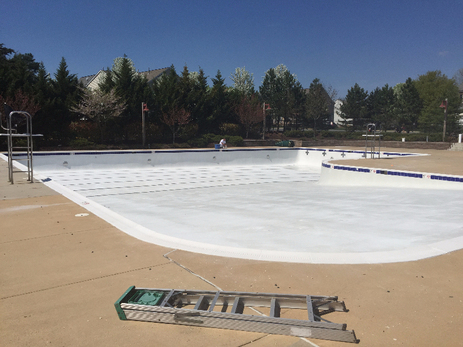Finishing the Whitecoat: Curing New Plaster

Spring is here, and it is the busiest time for resurfacing pools.
Spring is here, and it is the busiest time for resurfacing pools. While the process of prepping the pool surface and the applying the new plaster coat can take several weeks, curing the new surface can take a month to complete, and requires daily attention to ensure a good finish. This process needs to be completed by a qualified professional, and it should be included in the price of the service. There are many steps that must be taken after the last trowel stroke is drawn, and the process needs to start immediately.
Fill the Pool!
New plaster cures underwater through hydration, so it is important to get the pool filled as quickly as possible. Depending on the source of the fill and the volume of the pool, it is often necessary to have water trucked in to ensure the plaster does not dry out and cause cracking. In addition to cracking there are a number of issues that can arise from improperly filling a newly-plastered pool, and the pool contractor should monitor the fill to prevent them from happening.
Filter System Start-Up
Once the pool is completely full, the filter system needs to be started up so the water can circulate. It is important to first make sure the filters are clean before discharging water into the pool. If there are any heaters on the system it’s a good idea to isolate and bypass them to prevent any additional metals dissolving in the water, and possibly staining the fresh plaster. If there are any issues with the filter system that prevent proper operation, then they need to be identified and remedied as soon as possible. Good circulation and filtration are essential to maintaining water chemistry, and properly curing the plaster.
Water Chemistry
Maintaining the water chemistry during the curing process is extremely important, and should be done on a daily basis. An initial test of the source water should be performed when the fill begins so the correct chemicals are on hand to make the necessary adjustments once the pool is full and filtering. The total alkalinity of the water needs to be adjusted to the correct level on start-up, and due to the alkaline nature of the plaster the pH will need to be closely monitored and adjusted. After the first four day, it will be necessary to adjust calcium hardness to the minimum recommended range in order to keep the water from leaching calcium from the plaster. Failure to maintain these factors can result in an uneven and rough appearance to the plaster as well as surface damage. In addition, metals in the source water may need to be addressed with sequestering agents to prevent staining.
Brushing the Pool
The first two weeks are critical to ensuring a well-cured and lasting plaster finish. In addition to the diligent maintenance of water chemistry, the entire newly-plastered surface of the pool needs to be brushed with a nylon-bristled pool brush twice a day. Brushing will help dislodge dirt, debris, and plaster dust from the surface, and proper technique will help move the dust to the pool’s main drains where they can be filtered out of the water. This is important because the pool can’t be manually vacuumed with a standard commercial vacuum head for at least two weeks because the wheels will leave track marks in the “soft” surface. If plaster dust is not properly removed it can adhere to the surface as scale, and result in a rough surface.
Seeing the Cure through
After the first two weeks the pool should be free of plaster dust, and may be vacuumed. The pool will no longer require twice-daily brushing, and the chemistry should be relatively stable at this point. Over the next two weeks the pool will need regular cleaning, and the calcium hardness of the water should be slowly increased, not to exceed 200 parts per million about the 28th day from the start of the process. Regular water quality should be checked frequently and maintained properly throughout the season in order to ensure a long-lasting finish.
Written by: Peter Makela








